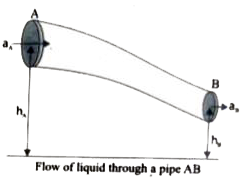State and prove Bernoulli's theorem for a flow of incompressible, non-viscous, and streamlined flow or fluid.Solution in Tamil

Bernoulli.s theorem: According to Bernoulli.s theorem, the sum of pressure energy, kinetic. a + energy, and potential energy per unit mass of an incompressible, non-viscous fluid in a streamlined flow remains a constant. Mathematically
=P2+12v2+gh = constant
This is known as bernoulli.s equation
Proof: Let us consider a flow of liquid through a pipe AB. Let V be the volume of the liquid when it enters A in a time i which is equal to the volume of the liquid leaving B in the same time. Let aA,vA and PA be the area of cross section of the tube, velocity of the liquid and pressure exerted by the liquid at A respectively. Let the force exerted by the liquid at A is
FA=PAaA
Distance travelled by the liquid in time t is d=vAt
Therefore, the work done is W=FAd=PAaAvAt
But aAvAt=aAd=V volume of the liquid entering at A.
Thus, the work done is the pressure energy (at A), W=FAd=PAV
Pressure energy per unit volume at A=pressure energy volume =PAVV=PA
Pressure energy per unit mass at A=pressure energymass=PAVm=(PAm)=PAρ
Since m is the mass of the liquid entering at A in a given time, therefore, pressure energy of the liquid at A is
EPA=PAV=PAV×(mm)=mPAρ
Potential energy of the liquid at A,
PEA=mghA
Due to the flow of liquid, the kinetic energy of the liquid at A, KEA=12mv2A
Therefore, the total energy due to the flow of liquid at A,
EA=EPA+KEA+PEA
EA=mPAρ+12mv2A+mghA
Similarly, let aB,vB and PB be the area of cross section of the tube, velocity of the line and pressure exerted by the liquid at B. Calculating the total energy at FB . we get
EB=mPBρ+12mv2B+mghB
From the law of conservation of energy,
EA=EB
mPAρ+12mV2A+mghA=mPBρ+12mv2B+mghB
mPAρ+12mV2A+mghA=PBρ+12v2B+ghB= constant
Thus , the above equation can be written as
Pρg+12v2g+h =constant
The above equation is the consequence of the conservation of energy which is true until there is no loss of energy due to friction. But in practice, some energy is lost due to friction. This arises due to the fact that in a fluid flow, the layers flowing with different velocities exert frictional forces on each other. This loss of energy is generally converted into heat energy. Therefore, Bernoulli.s relation is strictly valid for fluids with zero viscosity or non-viscous liquids. Notice that when the liquid flows through a horizontal pipe, then
h=0⇒Pρg+12v2g = constant
Topper's Solved these Questions
- EXAMINATION QUESTION PAPER MARCH 2019BOOK - FULL MARKSCHAPTER - EXAMINATION QUESTION PAPER MARCH 2019EXERCISE - PART-III
9 Videos
- EXAMINATION QUESTION PAPER - JUNE 2019BOOK - FULL MARKSCHAPTER - EXAMINATION QUESTION PAPER - JUNE 2019EXERCISE - PART IV
10 Videos
- GRAVITATIONBOOK - FULL MARKSCHAPTER - GRAVITATIONEXERCISE - ADDITIONAL QUESTIONS SOLVED (Numerical Problems)
18 Videos
Similar Questions
What is the torque of the force →F=3ˆi−2ˆj+4ˆk acting at a point →r=2ˆi+3ˆj+5ˆk about the origin?
View SolutionExplain in detail the triangle law of addition.
View SolutionA geo-stationary satellite is orbiting the Earth of a height of 6R above the surface of Earth R being the radius of the Earth calculate the time period of another satellite at a height of 2.5R from the surface of Earth.
View Solutionआदर्श द्रव के धारा-रेखीय प्रवाह के लिये बरनौली प्रमेय का उल्लेख कीजिए ।
View SolutionAssertion : Bernoulli's theorem is applicable only on laminar flow. Reason : Laminar flow is consider to be non viscous.
View SolutionBernouli's equation for a steady streamline flow of a non-viscous incompressible fluid expresses the principle of
View SolutionState and prove Bernoulli's theorem for a flow of incompressible, non-viscous, and streamlined flow or fluid.
View SolutionState and prove Bernoulli's theorem for a flow of incompressible, non-viscous, and streamlined flow or fluid.
View SolutionState and prove Bernoulli's theorem for a flow of incompressible, non-viscous, and streamlined flow or fluid.
View SolutionState and prove Bernoulli's theorem for a flow of incompressible, non-viscous, and streamlined flow or fluid.
View SolutionBernoulli's equation for steady, non-viscous, incompressible flow expresses the:
View SolutionState and prove Bernoulli's theorem.
View SolutionFor a uniform flow of an incompressible, non-viscous fluid the Bernoulli's theorem expresses,
View SolutionState and prove Bernoulli's theorem for a flow of incompressible, non-viscous, and streamlined flow or fluid.
View SolutionState and prove Bernoulli's theorem for a flow of incompressible, non-viscous, and streamlined flow or fluid.
View Solution
